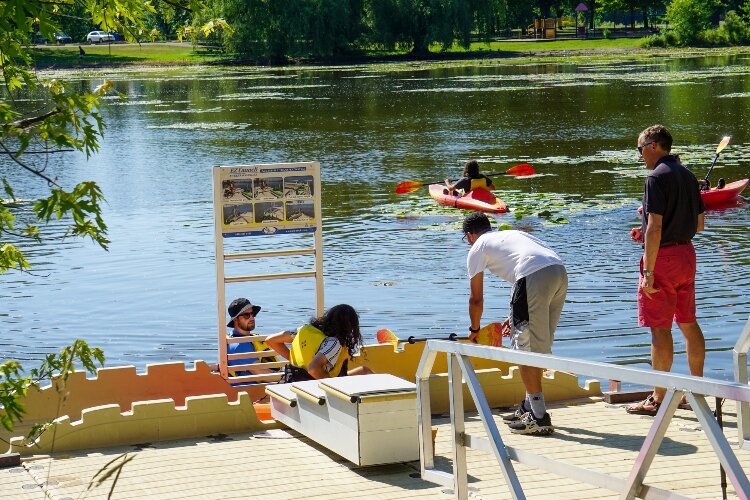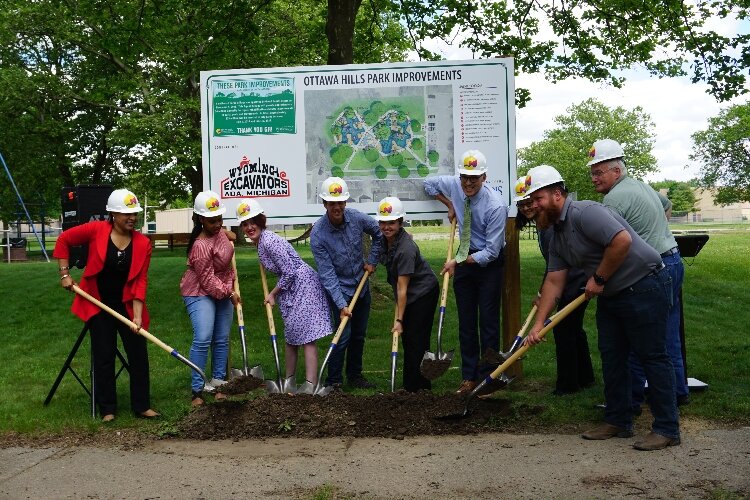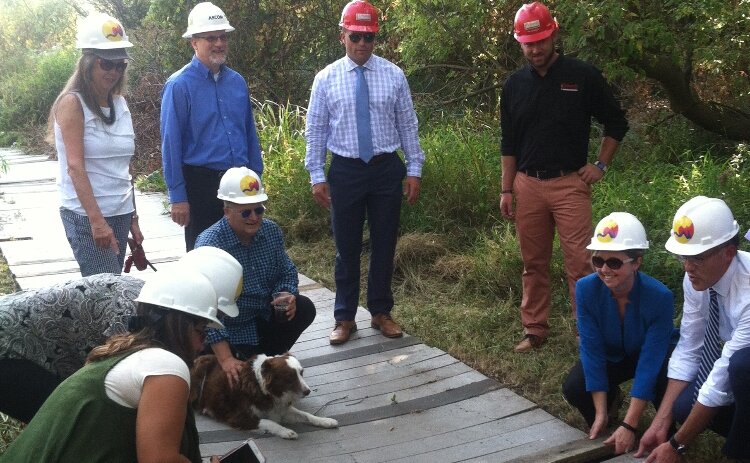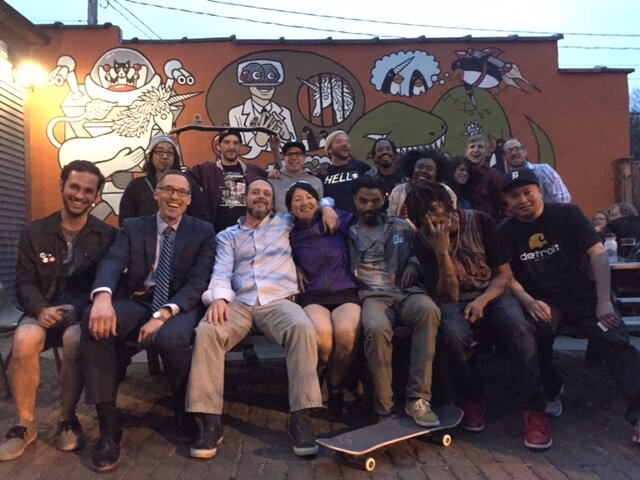David Marquardt reflects on decade of transforming GR parks
After a decade of revitalizing Grand Rapids parks, David Marquardt steps into a new leadership role in Kalamazoo.
When David Marquardt thinks about his 10-year tenure leading Grand Rapids’ Parks and Recreation Department, he views his legacy through the lens of collaboration, community trust, and long-term investment.
That chapter came to a close in July when Marquardt began his new role as deputy city manager in Kalamazoo.
“I feel grateful to have been part of a moment where so many people came together to believe in what public parks could be,” Marquardt says. “The work we did was only possible because of what had already been set in motion.”

When Marquardt arrived in Grand Rapids in 2015, the city’s parks system was just beginning to recover from the effects of the Great Recession of 2008. Years of budget cuts and structural changes had taken a toll. The department had been merged into Public Works —something that then-City Manager Greg Sundstrom confided in Marquardt was a mistake — before being re-established as a standalone entity.
Yet the timing of Marquardt’s arrival couldn’t have been better. In 2014, Grand Rapids voters had overwhelmingly approved a seven-year dedicated parks millage, and a new nonprofit, Friends of Grand Rapids Parks, had just begun organizing grassroots support around green space revitalization.
“Those two pieces gave us momentum,” Marquardt says. “They set the stage for a new vision — and for collaboration that reached far beyond city government.”
‘Reimagine the mission’
Rather than rushing into capital improvements, Marquardt prioritized listening.
“We deliberately slowed things down to reimagine the mission,” he says. “We asked the community, ‘What do you want your parks to be?’ And people responded with passion and clarity.”

Out of those conversations came a new mission that emphasized stewardship, equity, and connection to nature.
“The old language was about providing leisure services,” Marquardt says. “We evolved that into creating inspirational experiences through the collaborative stewardship of our natural, educational, and cultural resources.”
That updated vision resonated not only with residents but also with local partners and funders. One of the first collaborative projects under Marquardt’s leadership was a tree canopy study co-led with Friends of Grand Rapids Parks.
“We wanted to understand where the gaps were — where neighborhoods lacked tree cover and why,” he says. “That allowed us to target tree planting where it was needed most.”
The next big step was an asset inventory.
“We didn’t know what we had, where it was, or what condition it was in,” Marquardt says. “That’s not a great place to be if you’re trying to make smart investments.”
Updating the mission
With support from the Dyer-Ives Foundation in Grand Rapids, the city launched a comprehensive study of every asset in its park system — from swing sets and restrooms to trails and basketball courts.
“That gave us a roadmap,” Marquardt says. “It allowed us to invest more strategically and equitably.”

The resulting 2017 master plan reflected a notable shift in community priorities. A statistically valid survey revealed that residents were less interested in traditional sports infrastructure and more drawn to natural areas, trails, and educational programming.
“We saw this move away from baseball diamonds and tennis courts toward trail connectivity and simpler, more meaningful ways to connect with nature,” Marquardt says. “Things like paddling on the river or learning about the local environment.”
This shift led to the creation of the Eighth Grade Paddling Experience in partnership with Grand Rapids Public Schools.
“We put 1,000 eighth graders on the Grand River every year,” he says. “It was about giving them access to their own city in a new way — learning, exploring, connecting.”
Throughout his tenure, Marquardt emphasized public-private partnerships. One standout collaboration was with the nonprofit Has Heart, which supports veterans through art and entrepreneurship.
“Michael Hyacinthe came to me with a vision: transform a historic but vacant building in Veterans Memorial Park into a coffee shop that also serves the veteran community,” Marquardt says. “It checked every box — activating space, preserving history, and serving people. We were all in.”
The result was a vibrant gathering place that reinvigorated the park while supporting a meaningful mission. “That project wouldn’t have happened without trust — without saying yes to someone else’s vision and being willing to help it grow,” he says.
Community backs new mission
As Grand Rapids’ park system gained momentum, so did community support. In 2019, voters returned to the polls and approved a new millage — this time with a permanent commitment and increased funding. The measure passed with 73% of the vote.
“That level of support doesn’t happen by accident,” Marquardt says. “It happens when people see results, feel ownership, and trust where their money is going.”
Former Mayor Rosalynn Bliss played a key role in building that trust. Known for her environmental focus, Bliss was an early champion of nature-based experiences in city spaces. Her support helped connect Grand Rapids to national networks such as the Children & Nature Network and the National League of Cities.

“She was a mega-champion for parks,” Marquardt says. “I remember her coming back from a conference in Minneapolis and saying, ‘Let’s bring that canoe experience here.’ So we did.”
Stacy Bare, executive director of Friends of Grand Rapids Parks, remembers speaking to Marquardt for the first time when he was working with the Outdoor Foundation in Utah and doing a grants review for what would become Grand Rapids Outdoors.
“After getting off the phone with David for the first time,” Bare said, “I told my wife, ‘If we ever move from Utah, G.R. could be a great spot. They’re doing some incredible things in their parks.’ Lo and behold, we did move to G.R. in 2022 because of the strong community orientation towards parks and green space. David leaves an incredible legacy for us to build upon.”
City Manager Mark Washington credits Marquardt’s ability to bring people together as a driving force behind the department’s progress.

“Since David joined the City of Grand Rapids in January 2015, we have achieved significant improvements in our parks system through key partnerships with stakeholders and advocates, local and state political support, and strong staff work under David’s leadership,” Washington says. “David leaves us with a capable department of dedicated employees, a thriving parks system, and numerous community partnerships.”
Marquardt’s background in landscape architecture and public administration helped him bridge design and policy. Before coming to Michigan, he was planning division manager for Denver’s parks department, overseeing a $500 million capital asset portfolio.
“I came from the city and county of Denver, where I managed the city’s planning and projects division,” Marquardt says. “That experience gave me a systems-level view of how cities can use parks to advance broader community goals.”
Broader portfolio
In his new role as deputy city manager in Kalamazoo, Marquardt is expanding that systems focus. He now oversees not only parks and recreation but also public services and communications.
“I wasn’t looking to leave Grand Rapids,” he says. “But I was looking to grow. Kalamazoo offered an opportunity to take what I’ve learned and apply it on a larger scale.”

Kalamazoo City Manager James Ritsema sees Marquardt’s blend of vision, strategy, and community values as a strong fit.
“David’s extensive municipal experience in parks and recreation, public services, and communications will be a great asset to Kalamazoo,” Ritsema says. “We believe he will play a crucial role in helping us achieve our strategic vision.”
Patrick McVerry, director of Kalamazoo’s Department of Parks and Recreation, says the department’s goal is to create a more vibrant and inclusive city “by creating partnerships, providing safe connections, enhancing accessibility, and implementing park improvements with a strong focus on equity.”
“David’s experience, leadership, and guidance will be an excellent addition to our city leadership,” McVerry says. “He is a very respected professional in our industry, and we are extremely excited to have him as our new deputy city manager.”
Marquardt sees continuity between his old and new roles.
“What I loved — and still love — about Grand Rapids is that people and organizations come together in very meaningful ways,” he says. “That spirit of collaboration helped us accomplish more than any one department could on its own.”
As he looks ahead, Marquardt remains committed to the power of public spaces to build stronger, healthier communities.
“Parks are not just nice-to-haves,” he says. “They are essential. They shape how we connect, how we learn, and how we care for one another. That belief will continue to guide me, wherever I go.”
Photos courtesy of the City of Grand Rapids Parks and Recreation Department.
The Parks-People-Possibility series, made possible through a partnership with Friends of Grand Rapids Parks, will spotlight community-led initiatives to improve, create, and sustain the city’s parks and green spaces.










